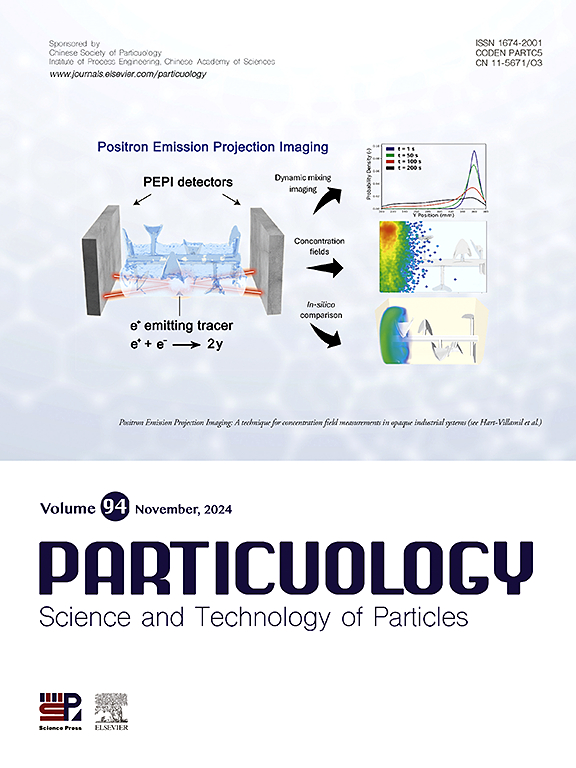采用粗单元对稀大颗粒CFD-DEM中阻力计算的改进:阻力分布的有效投影面积
IF 4.3
2区 材料科学
Q2 ENGINEERING, CHEMICAL
引用次数: 0
摘要
本研究解决了CFD-DEM模拟中的一个关键挑战:当单元尺寸超过颗粒尺寸时,流体网格单元的阻力准确分配。由于粒子质心的离散性,传统的粒子质心法在粒子跨越胞体边界时往往会导致阻力突变。为了克服这一限制,我们提出了一种新的算法,计算计算单元内粒子的有效投影面积(EPA)的解析解,与相对速度方向对齐。阻力然后按比例缩放根据这个EPA计算。本文给出了我们的算法的具体实现案例,重点关注细胞顶点驻留在粒子边界内的场景。为了确定EPA,我们引入了一种基于面向风表面关系的创新分类方法。广泛的验证涉及100,000个具有不同细胞-粒子相对位置的测试用例(所有测试用例都受顶点-粒子条件的约束),使用我们的方案系统地分为18种类型。结果表明,所有计算的EPA值都在理论范围内,证实了分类的全面性。通过5个经典的粒子运动模拟,我们表明我们的方法在时间步长上保持了连续的EPA变化,这是对PCM特征不连续性的显著改进。在单颗粒沉降的CFD-DEM框架内实现,可以产生与实验数据密切匹配的终端速度,同时确保流体单元之间的阻力平滑转换。与PCM方法相比,该方法将终端沉降速度的相对误差降低了约43%。此外,双粒子沉降的对比研究表明,我们的算法相对于传统的PCM方法具有优越的性能。对于粒子1,用该方法预测的终端垂直速度与PCM相比,相对误差降低了约17%。这些进展显著提高了颗粒-流体相互作用问题的模拟保真度,在这些问题上,细胞-颗粒尺寸比挑战了传统方法。本文章由计算机程序翻译,如有差异,请以英文原文为准。

Improved drag force calculation in CFD-DEM using coarse cell for dilute large-sized particles: Effective projected area for drag force distribution
This study addresses a critical challenge in CFD-DEM simulations: the accurate assignment of drag force to fluid mesh cells when the cell size exceeds particle sizes. Traditional particle centroid method (PCM) approaches often lead to abrupt drag force variations as particles cross cell boundaries due to their discrete nature. To overcome this limitation, we propose a novel algorithm that computes an analytical solution for the effective projected area (EPA) of particles within computational cells, aligned with the relative velocity direction. The drag force is then proportionally scaled according to this EPA calculation. The paper presents a specific implementation case of our algorithm, focusing on scenarios where a cell vertex resides within a particle boundary. For EPA determination, we introduce an innovative classification approach based on face-windward surface relations. Extensive validation involved 100,000 test cases with varying cell-particle relative positions (all constrained by the vertex-in-particle condition), systematically classified into 18 types using our scheme. Results demonstrate that all computed EPA values remain within theoretical bounds, confirming the classification's comprehensiveness. Through 5 classic particle movement simulations, we show that our method maintains continuous EPA variation across time steps - a marked improvement over PCM's characteristic discontinuities. Implementation within the CFD-DEM framework for single-particle sedimentation yields terminal velocities that closely match experimental data while ensuring smooth drag force transitions between fluid cells. Compared to PCM, the present method reduces the relative error in terminal settling velocity by approximately 43 %. Moreover, comparative studies of dual-particle sedimentation demonstrate our algorithm's superior performance relative to conventional PCM approaches. For Particle 1, the terminal vertical velocity predicted by the present method reduces the relative error by approximately 17 % compared to PCM. These advances significantly enhance simulation fidelity for particle-fluid interaction problems where cell-particle size ratios challenge traditional methods.
求助全文
通过发布文献求助,成功后即可免费获取论文全文。
去求助
来源期刊

Particuology
工程技术-材料科学:综合
CiteScore
6.70
自引率
2.90%
发文量
1730
审稿时长
32 days
期刊介绍:
The word ‘particuology’ was coined to parallel the discipline for the science and technology of particles.
Particuology is an interdisciplinary journal that publishes frontier research articles and critical reviews on the discovery, formulation and engineering of particulate materials, processes and systems. It especially welcomes contributions utilising advanced theoretical, modelling and measurement methods to enable the discovery and creation of new particulate materials, and the manufacturing of functional particulate-based products, such as sensors.
Papers are handled by Thematic Editors who oversee contributions from specific subject fields. These fields are classified into: Particle Synthesis and Modification; Particle Characterization and Measurement; Granular Systems and Bulk Solids Technology; Fluidization and Particle-Fluid Systems; Aerosols; and Applications of Particle Technology.
Key topics concerning the creation and processing of particulates include:
-Modelling and simulation of particle formation, collective behaviour of particles and systems for particle production over a broad spectrum of length scales
-Mining of experimental data for particle synthesis and surface properties to facilitate the creation of new materials and processes
-Particle design and preparation including controlled response and sensing functionalities in formation, delivery systems and biological systems, etc.
-Experimental and computational methods for visualization and analysis of particulate system.
These topics are broadly relevant to the production of materials, pharmaceuticals and food, and to the conversion of energy resources to fuels and protection of the environment.
 求助内容:
求助内容: 应助结果提醒方式:
应助结果提醒方式:


